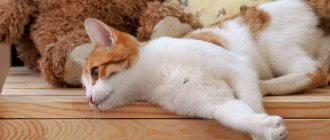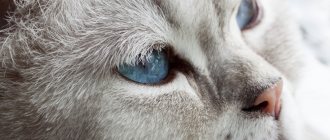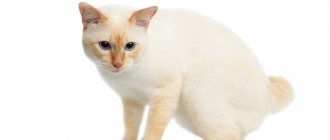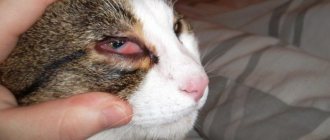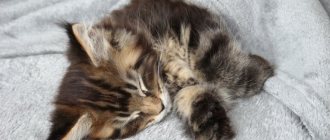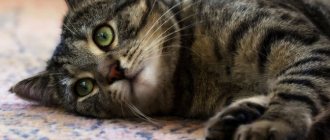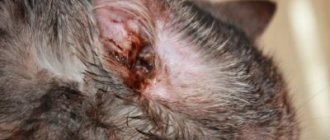A cat's nosebleeds may indicate temporary disruption of the integrity of blood vessels, and in some cases it is a serious symptom of a dangerous disease.
The intensity of nosebleeds varies - the faster the blood is released, the greater the danger looming over the pet.
In most cases, bleeding from the nasal cavity in cats occurs as a result of injuries to small vessels due to mechanical damage to the mucous membrane or during inflammatory processes. The mucous membrane lining the nasal cavity has a large number of small vessels and nerve endings.
Given the great mobility and curiosity of cats, nasal injuries are not that uncommon. If your pet experiences even one nosebleed, it is strongly recommended to visit a veterinarian. This will allow timely detection of possible pathology and avoid complications.
Should I worry?
Nosebleeds are an alarming symptom, but you should not panic. The animal needs to be calmed to reduce its blood pressure, which rises when overexcited.
Isolated cases and constant phenomena
If bleeding occurs regularly in an animal, this is a reason to urgently consult a veterinarian. It is important to find out whether the condition is accompanied by other problems: internal bleeding, lethargy, black stool.
In isolated cases, an animal's nose may bleed after playing with another pet or receiving injuries. Poisoning with rat poison is also accompanied by bleeding.
It is important to keep all chemicals in closed cabinets.
First aid
Before the doctor arrives or goes to the clinic, it is necessary to stop the bleeding at home.
The animal is calmed down, an ice pack is placed on the bridge of the nose, after wrapping it in a towel. Such a bundle should not make it difficult for your pet to breathe. Under the influence of low temperatures, blood vessels narrow and bleeding stops.
When is veterinary help needed?
If the owner cannot stop the bleeding using available methods, it is necessary to contact a veterinary clinic.
Regularly recurring bleeding should not be ignored. In this case, the help of a specialist is needed.
What should the owner do when bleeding is detected?
No panic!
First of all, it is important not to panic! Cats sense a person’s nervous tension, and their internal excitement also begins to increase. If a cat has a nose bleed due to high blood pressure, then the intensity of this process will only intensify. Therefore, it is important for the owner to control himself.
Use the cold!
Then you need to apply something cold to the bridge of your nose (for example, snow from the freezer, wrapped in a bag and a thin towel). The cold will help narrow the blood vessels and stop the bloody streams. Hold it carefully, without pressing too hard or blocking the nostrils, so as not to impede breathing. Periodically remove the cold object (compress) so as not to overcool the nose.
Carry out an inspection
Using regular wet wipes or paper towels, gauze pads and water, gently wash the nose and inspect it and the mouth.
It is important to remember at least the approximate time when the bleeding was discovered, the length of time during which it was stopped, and what unusual was noticed during the examination.
Go to the vet
If the bleeding does not stop and/or there are problems breathing, you should immediately go to the veterinarian. If the animal’s condition is satisfactory, a visit to a specialist is also mandatory, with the only difference being that at the first opportunity and without haste. You should also go to a veterinarian if the cause of the bleeding has been established, but the owner cannot eliminate it on his own.
If your kitten's nose is bleeding
If a similar phenomenon is found in small kittens, then there is no point in trying to find out the cause on your own: the nasal passages are very small, it is impossible to see anything yourself, and breathing may be impaired due to blockage of the nasal passages with coagulated blood. You must immediately look for a way to seek help from a specialist!
Causes of bleeding from the nose
The nasopharyngeal mucosa contains a large number of blood vessels. Its injury leads to the release of drops of blood. This can happen during a fight with another cat or dog, sniffing plants with thorns, or after falling from a height.
Other reasons:
Foreign body in the nasal passages: most often these are the remains of plants or cereal grains. A veterinarian will be able to detect the object during rhinoscopy.- Tumor. The neoplasm does not make itself felt at first. Later, heavy bleeding appears due to tissue rupture. You can suspect such a problem if the nose is swollen, the shape of the back has changed, or the muzzle as a whole is deformed. This pathology is more common in older cats and almost never in young cats and newborn kittens.
- Inflammation in the oral cavity can also provoke blood flow. Most often this is a tooth abscess.
- If your cat produces blood when sneezing, clots of mucus appear, a bacterial or viral disease is suspected.
- An increase in pressure provokes a rupture of capillaries, and blood comes out.
Decreased blood clotting is manifested by heavy bleeding, including nosebleeds.
Diagnosis by a veterinarian
First of all, the veterinary specialist needs to provide complete information not only about the condition of the animal at the time of treatment, but also the lifestyle the day before.
A sample list of questions to determine the cause of a cat’s nosebleed is as follows:
- Has the owner or his family given you any medications in the last few days? Which ones exactly? For what purpose? Dosage?
- Have rat baits been used in the house? Is it possible for a cat/cat to gain access to them?
- Have you had contact with other cats? Fights?
- Could the cat injure itself - fall, get hit by a car, or someone could hit it?
- Is there watery eyes, snot, or sneezing? Does the cat rub its face with its paws?
- Is the bleeding one-sided or two-sided?
- Vomit? Character of vomit? Before the blood appears or after?
- State of stool? Is there blood in the stool?
- Are there problems with your mouth and teeth? Do you have bleeding in the mouth? Are the mucous membranes pale? Is there marbling?
- Does the cat have any signs of hemorrhage or swelling in its body (suspicion of subcutaneous bleeding).
- Is your pet breathing normally? Wheezing due to excessive blood flow from the nostrils?
- Allow your pet to be examined by a doctor for deformation of the muzzle, swelling of the bridge of the nose and any asymmetry. Are there any changes in the eyeballs? Tears?
In addition to collecting a detailed history (living conditions) of the animal, it may be necessary to do a number of tests and clinical tests:
- general analysis of blood and urine, as well as their biochemistry (allows you to assess the state of the cellular composition and the presence of red blood cells in the urine);
- serological tests to determine the presence of rickettsia and fungal agents;
- checking the status of blood pressure (normally, a cat’s indicators should be at the level of 120/70 – 180/130, depending on the age and condition of the cardiovascular system);
- rhinoscopy, and, if necessary, an x-ray of the nose;
- X-ray of the chest (blood from the nose and mouth may appear due to rupture of the lungs and other pulmonary lesions);
- deep endoscopic examination;
- biopsy of the mucous membrane from the nasal passages;
- diagnostic surgery.
Some of the diagnostics listed may require local or general anesthesia!
Only after collecting anamnesis, clinical examination and appropriate tests can an accurate analysis be performed and adequate treatment prescribed!
Main symptoms
Diseases accompanied by bleeding from both nostrils have a number of symptoms. By observing the animal, you can accurately determine the cause of this condition.
Decreased clotting
Some chronic diseases lead to this condition: viral leukemia, immunodeficiency, the effect of non-steroidal anti-inflammatory drugs, liver failure.
Symptoms: red spots on the gums, ears, pallor of the oral mucosa, lethargy, apathy.
Pulmonary hemorrhage
When lung tissue is injured, breathing and circulation are impaired. Most often, the liver suffers, causing a decrease in blood clotting.
Symptoms: moderate to severe nosebleeds, shortness of breath, lethargy.
Nasal infections
If the animal sneezes blood or mucus comes out of the nose, a viral or bacterial infection is suspected.
Parasites
All types of blood-sucking insects and helminths lead to a decrease in platelet levels, resulting in impaired blood clotting.
Intoxication
When poisonous substances enter a cat's body, it is accompanied by internal bleeding. This condition is often observed during intoxication with rat poison.
An animal can become poisoned by eating a poisoned rodent or in another way if the poison is in a place accessible to the animal.
What is the danger of nosebleeds?
In some cases, the presence of bloody discharge from a cat's nostrils requires emergency veterinary attention. As a rule, this is indicated by additional symptoms. Therefore, it is worth examining the animal as soon as bloody discharge from the nose appears.
Signs that accompany a nosebleed and indicate the need to take your cat to a veterinarian:
- When you sneeze, a lot of blood is released;
- There is deformation of the muzzle, swelling on the animal’s body;
- The mucous membrane of the oral cavity acquires a marble color;
- Presence of symptoms of periodontal disease or gumboil;
- The animal's feces become black, acquiring a viscous consistency. This indicates that some of the blood is going inward rather than flowing outward. In such a situation, urgent diagnosis is necessary;
- The presence of an unpleasant odor from the mouth and nose;
- Difficulty breathing;
- The animal sleeps a lot;
- Loss of appetite.
If you have such symptoms, you should contact a specialist for examination and further diagnosis.
Diagnostics
The examination is aimed at identifying the cause of ill health.
Diagnostics is carried out comprehensively. This can only be done in a veterinary clinic.
What questions will the veterinarian ask?
It is important for the pet owner to remember all the symptoms that accompany bleeding in a pet.
At the clinic, the veterinarian clarifies the following:
- what medications does the cat take?
- are there toxic substances in the house;
- whether the pet was walking unattended;
- presence of injuries;
- what symptoms accompany bleeding: sneezing, vomiting, bloody diarrhea, difficulty breathing;
- does the pet rub its nose with its paw?
blood is discharged from one nostril or from both;- what is the condition of the animal’s oral cavity, the presence of diseased teeth, blood residues, changes in the color and structure of the gums;
- the presence of subcutaneous hemorrhages, bruises, hemorrhages;
- whether the animal has had a noticeable change in the shape of its muzzle, nose, whether the eyeballs are symmetrical, whether there is discharge from the eyes.
Accurate answers will help the veterinarian clarify the situation and partially determine the cause of deterioration in health, accompanied by nasal discharge.
Types of diagnostics
To determine the causes of bleeding, a series of clinical tests, radiography, and rhinoscopy are prescribed.
Blood tests
A complete blood count is indicated to determine platelet levels.
A urine test is carried out to determine the general condition of the body and the presence of inflammatory processes. This test also helps evaluate kidney function.
A biochemical blood test shows how the internal organs function and whether blood clotting indicators are normal.
Tests
Serological tests are performed to detect fungal and other infections.
X-ray
An X-ray examination of the nose allows you to assess the condition of the roots of the teeth, sinuses, the presence of a tumor, and the degree of destruction of cartilage tissue.
Nasal examination
Using rhinoscopy, the nasal passages are examined, the presence of foreign bodies is determined, and they are removed.
Sanitation of the oral cavity
When examining the teeth, teeth are cleaned, paying special attention to the root area, since inflammation of the tooth root affects the nasal sinus.
Biopsy
If traces of a tumor are noticed on an x-ray, part of the damaged tissue is taken for examination. A tissue biopsy helps determine the malignancy of the tumor.
Surgical method
It is used if it is necessary to remove a hard-to-reach foreign body in the nasal passage or take part of the tissue for a biopsy. The method is traumatic, the intervention is performed under anesthesia.
Prevention of allergies and colds
To prevent allergic rhinitis, it is necessary to limit interaction with the irritant that causes symptoms of the disease and create a hypoallergenic environment6:
- install air filters in the house;
- change cotton and down bedding to padding polyester;
- get rid of potential dust accumulators (curtains, carpets, etc.);
- if necessary, part with pets;
- treat surfaces with acaricidal agents against dust mites.
Cold prevention involves strengthening the body's defenses and maintaining a high level of immune status. Preventive measures include:
- hardening, systematic sports;
- a healthy diet rich in vitamins, probiotics and proteins;
- regular ventilation of premises;
- vaccination;
- maintaining personal hygiene.
If the epidemiological situation is unfavorable, social contacts should be limited and a protective medical mask should be worn.
Help an animal
Treatment for bleeding depends on the test result. If an animal is diagnosed with an infectious disease, a course of antibiotics is prescribed; for fungal infections, fungicidal drugs are prescribed.
If you have high blood pressure (hypertension), appropriate medications are prescribed to lower it.
Complex injuries, deformation of the nasal passages, and neoplasms are treated only surgically. A deeply stuck foreign object is removed with surgical instruments using anesthesia.
In case of poisoning with rat poison or hemophilia, vitamin K is indicated. Vasoconstrictor drugs and Adrenaline are injected into the nasal cavity.
For nosebleeds, symptomatic treatment and the use of drugs that promote blood clotting are indicated.
Traditional methods
If parasites are the cause of your pet's nosebleeds, they need to be removed. A decoction of tansy helps against fleas. It is used to rinse the animal's fur after bathing. In other cases, folk remedies are powerless.
At home, stop bleeding by applying cold to the back of the cat's nose. It is impossible to treat a pathology without knowing the cause. Wrong actions of the owner can cause the development of irreversible consequences.
The animal needs specialist consultation, a complete and comprehensive examination, and complex therapy.
How to treat a cat
First of all, the pet needs to stop the bleeding so that the animal does not suffer from excessive loss. Sedative medications may also be useful to calm your cat. In panic, he may cause himself even greater harm.
If the pet is calm or you can restrain it (a good way is to bandage the whole body up to the neck with a blanket), then you need to put an ice compress or a cold towel on its nose. This will help narrow the damaged capillaries. Let's use this method to treat minor injuries. Drops are usually not used.
The doctor may also use adrenaline, which stops the bleeding. In the most advanced situations, the veterinarian uses anesthesia to examine the nasal cavity. The cat, severely injured, begins to run quickly, interfering with the inspection.
Treatment of the problem depends on the causative agent. If the cause is an infection, then the pet is prescribed antibiotics and other antiviral medications. It is possible to prescribe surgery, but before surgery the animal must undergo chemotherapy. When the cause is an oral disease, the pet will have to be operated on. The same is true with tumors. If the doctor does not detect any pathologies, then a cold compress is applied to the face and a vasoconstrictor is administered.
© shutterstock
If you do not want your pet to have a nose bleed, then you need to regularly bring him to the veterinary clinic for vaccination against contagious infections . You also need to feed the animal nutritious food containing vitamins and essential microelements. The veterinarian should be visited not only in critical situations, but also for prevention. It is recommended to visit once every couple of months. He will notice in time that your pet is sick.
Features during treatment
Many owners have a question: how can periodontal disease cause nosebleeds in a cat? There is a connection between periodontal disease and bleeding due to the structure of the tooth. The root of a cat's tooth is very long. When periodontal disease begins, the decay products of the infection reach the alveoli. There are a lot of blood vessels in this area that are affected by the virus. Damaged vessels begin to bleed, resulting in fluid flowing out of the nose.
The reason may be completely harmless and harmless. One of them is thermal shock affecting the capillaries. They burst, causing bleeding. All this happens because cats are very sensitive to changes in high and low temperatures.
If no pathologies are detected
In order not to provoke a new attack, the animal is protected from stress. This helps stabilize emotional levels and pressure.
You cannot leave a cat on the street unattended: it can suffer from the actions of street animals, damage the nasal mucosa from hard leaves and thorns of plants, and their seeds.
It is important to undergo regular veterinary and dental examinations . This will prevent the development of inflammatory processes.
A nutritious diet with the introduction of vitamin complexes is the best prevention of anemia and a decrease in the level of platelets in the blood.
The relationship between bleeding and periodontal disease
It is common to experience bleeding due to dental disease. This is explained by the fact that the upper jaw bone of a cat is quite thin, and the roots of the fangs are located at great depths. Therefore, if inflammatory processes are present in them, their products can enter the nasopharynx. In this case, the disease also affects the blood vessels. This causes bleeding.
Veterinary assistance when visiting the clinic
First aid will definitely be aimed at stopping the bleeding. All subsequent manipulations and treatment procedures will be carried out only after an accurate diagnosis has been made and the reason why the cat is bleeding has been determined.
Means for symptomatic stopping of bleeding from the nasal cavity:
- Adrenaline in a dosage of 0.02-0.05 ml (1:1000) subcutaneously (cannot be used if nosebleeds are associated with lung injury, as it dilates the pulmonary vessels).
- Antipyrine 20% or hydrogen peroxide for wetting thin cotton-gauze swabs that are inserted directly into the nasal passages.
- Ephedrine 2% (with caution) subcutaneously or into the muscle in a dose of 1-30 mg under strict supervision. Do not use in pregnant women or with high blood pressure. Used for prolonged rhinitis with blood.
- Calcium chloride or gluconate 10% - slowly intravenously in a dose of 5-10 ml, depending on the intensity of the pathology.
- Vikasol - into the femoral muscle at a dose of 1-2 mg/kg body weight (usually 10 mg of vitamin K in 1 ml of solution), after warming the ampoule in your hands.
If the cat continues to bleed from the nose and his general condition worsens, a decision is made to put the animal under anesthesia for diagnostic surgery. Identified causes are eliminated immediately after identifying the source of bleeding in various ways (removal of tumors or foreign objects, coagulation of blood vessels, etc.).
Depending on the type of infectious disease identified, antimicrobial, antiviral or antifungal therapy is prescribed. In case of extensive blood loss - restorative-replacement drips.
